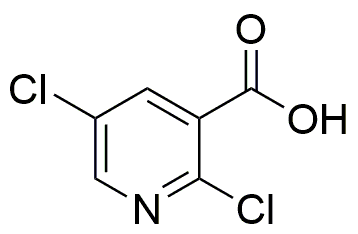2,5-Dichloronicotinic acid is widely utilized in research focused on:
- Pesticide Development: This compound serves as a key intermediate in the synthesis of various agrochemicals, particularly insecticides and herbicides, enhancing crop protection.
- Pharmaceutical Research: It is used in the development of pharmaceuticals, particularly in creating compounds that target specific biological pathways, offering potential treatments for various diseases.
- Material Science: The chemical is applied in the production of novel materials, such as polymers and coatings, which can improve durability and resistance to environmental factors.
- Analytical Chemistry: It acts as a standard in analytical methods, aiding in the detection and quantification of other substances in complex mixtures.
- Biochemical Studies: Researchers utilize it to investigate biochemical pathways and mechanisms, providing insights into cellular processes and disease mechanisms.
General Information
Properties
Safety and Regulations
Applications
2,5-Dichloronicotinic acid is widely utilized in research focused on:
- Pesticide Development: This compound serves as a key intermediate in the synthesis of various agrochemicals, particularly insecticides and herbicides, enhancing crop protection.
- Pharmaceutical Research: It is used in the development of pharmaceuticals, particularly in creating compounds that target specific biological pathways, offering potential treatments for various diseases.
- Material Science: The chemical is applied in the production of novel materials, such as polymers and coatings, which can improve durability and resistance to environmental factors.
- Analytical Chemistry: It acts as a standard in analytical methods, aiding in the detection and quantification of other substances in complex mixtures.
- Biochemical Studies: Researchers utilize it to investigate biochemical pathways and mechanisms, providing insights into cellular processes and disease mechanisms.
Documents
Safety Data Sheets (SDS)
The SDS provides comprehensive safety information on handling, storage, and disposal of the product.
Product Specification (PS)
The PS provides a comprehensive breakdown of the product’s properties, including chemical composition, physical state, purity, and storage requirements. It also details acceptable quality ranges and the product's intended applications.
Certificates of Analysis (COA)
Search for Certificates of Analysis (COA) by entering the products Lot Number. Lot and Batch Numbers can be found on a product’s label following the words ‘Lot’ or ‘Batch’.
Número de catálogo
Número de lote/lote
Certificates Of Origin (COO)
This COO confirms the country where the product was manufactured, and also details the materials and components used in it and whether it is derived from natural, synthetic, or other specific sources. This certificate may be required for customs, trade, and regulatory compliance.
Número de catálogo
Número de lote/lote
Safety Data Sheets (SDS)
The SDS provides comprehensive safety information on handling, storage, and disposal of the product.
DownloadProduct Specification (PS)
The PS provides a comprehensive breakdown of the product’s properties, including chemical composition, physical state, purity, and storage requirements. It also details acceptable quality ranges and the product's intended applications.
DownloadCertificates of Analysis (COA)
Search for Certificates of Analysis (COA) by entering the products Lot Number. Lot and Batch Numbers can be found on a product’s label following the words ‘Lot’ or ‘Batch’.
Número de catálogo
Número de lote/lote
Certificates Of Origin (COO)
This COO confirms the country where the product was manufactured, and also details the materials and components used in it and whether it is derived from natural, synthetic, or other specific sources. This certificate may be required for customs, trade, and regulatory compliance.


